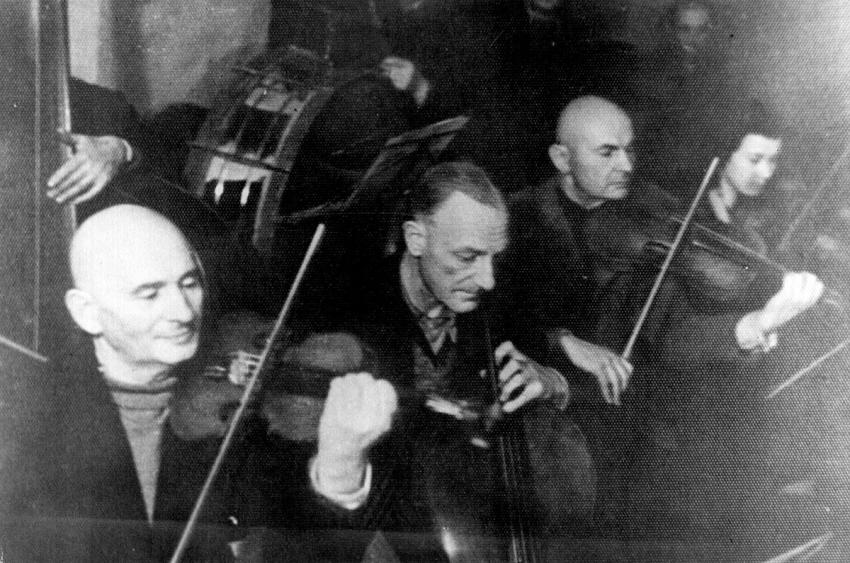During the war, European Jewry was faced with a constant struggle for their very survival. Yet even under such terrible conditions there were those who acted in areas that went beyond the necessities of human existence: they risked their lives - deliberately and intentionally - for higher values, including educating their children, maintaining religious values and traditions and sustaining centuries-old cultural activities. Unfortunately, not all those who succeeded survived the hell that was the Holocaust, but their deeds themselves bear witness to power of the human spirit.
One phenomenon that testifies to an impressive level of spiritual survival is the efforts made by Jews to document their lives in the ghettos and the camps. Artists and intellectuals, children and ordinary people, wrote and drew in order to document the fear and crisis that pervaded Jewish society. These activities were not only helpful in allowing many to rise above the humiliations and injuries they suffered, but also sometimes alerted the free world to the reality of their lives. Even in the camps themselves, one finds evidence of activity through which the prisoners could - if only in their imaginations - transcend the barriers of their status and of the surrounding camp environment. While only a few took part in these activities, their importance lies not in their quantity but in the strength of spirit needed for their realization within the reality of persecution and humiliation.
Despite the predatory reality endured by the Jews of Eastern and Western Europe, many people mobilized to assist those weaker than them, establishing mutual aid and welfare organizations. In the camps, helping others often became a matter of life and death, accompanied by difficult moral dilemmas. By helping another person - whether with food, clothing or work - the individual potentially jeopardized his own ability to survive. However, many Jews placed themselves in grave danger in order to save the lives of others, among them the Jewish partisan units, who rescued non-combatants, women and the elderly; and those who tried to protect the children and their special world. Similarly, despite their obvious powerlessness vis-à-vis German military might, the armed underground still managed to muster the strength to act and to rebel.
It is important to stress that the Holocaust took place in the heart of Christian Europe and before the eyes of millions of others. In many cases, hatred and persecution of the Jews became the accepted norm, and those who tried to aid the Jews had to act in opposition to the expectations of their surrounding society. The ability of a single individual to act according to moral principles even when public norms have completely collapsed should not be underestimated. Non-Jews who endangered their own lives, and at times the lives of those closest to them, are an impressive exception to the behavior exhibited by so many others. The activity of these Righteous Gentiles is a constant and exalted testament to the human spirit.
Our knowledge of the atrocities committed by the Nazis and their collaborators also raises serious questions concerning the humanity of the perpetrators. At first, many denounced the Germans and their collaborators as “beasts” and “monsters.” But the clearer the image of the murderers became, the more that was learned about the Nazi death machine, the more obvious it became that such a simplistic approach provides no answers. Most of the murderers were ordinary people, human beings who lived normal lives both before the war and afterwards, and sometimes even while they were engaged in their murderous work. Historians, psychologists and philosophers have tried to understand this phenomenon, and over the years have proposed many and complex explanations: some focused on the Nazi ideology and on German hatred of the Jews; others addressed the emotional mechanisms at work, as well as the historical circumstances that caused so many thousands of people to overcome moral barriers and to accept the death of innocent human beings as something legitimate and even desirable. Yet despite of the sophisticated arguments employed, one often remains unable to fathom the virulence of the hatred and the magnitude of the savagery. Nevertheless even when the human mechanism at work is not completely clear, it is impossible to ignore its essential humanity.
In a reality where murder became the norm, in a world where power endorsed unprecedented atrocities, there were many who were carried away, unable to endure the perpetual struggle for survival or adhere to the moral code of human society. Still, there were others who managed to behave differently. An examination of the humane responses in the face of the Holocaust, while understanding the reality in which they took place, emphasizes the spiritual fortitude that individuals and societies had to find in order to maintain their human spirit in the shadow of death.

